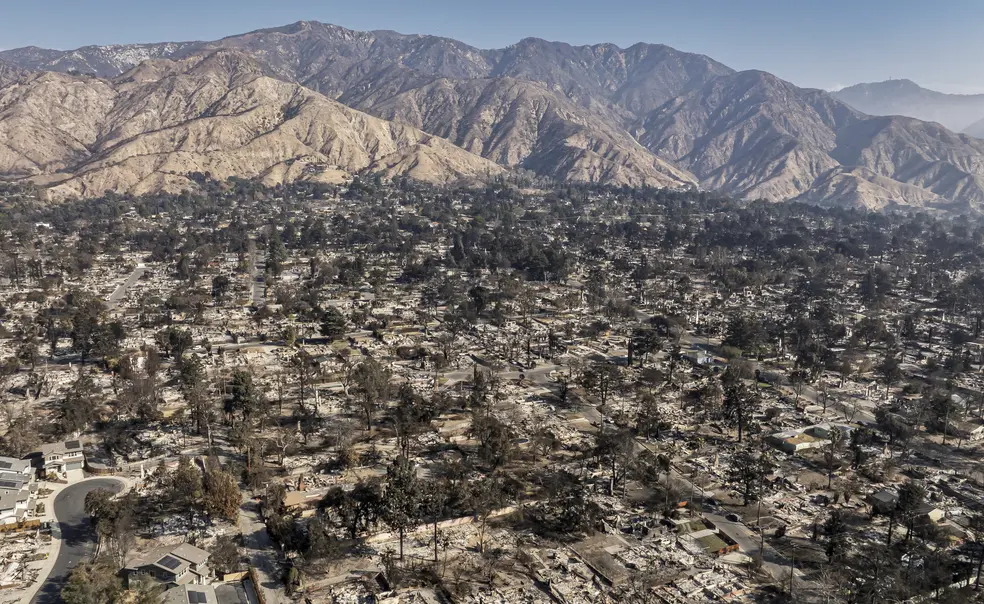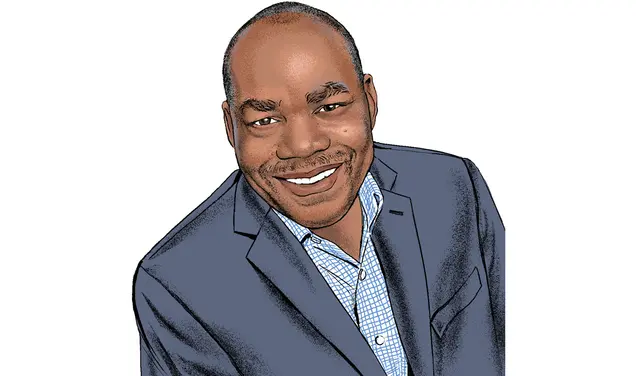‘The Worst Hellscape’: L.A. Fires Claim the Homes of Alumni
From Altadena to Malibu to Pacific Palisades, Princetonians are picking up the pieces. “When the bad stuff happens, my tendency is to try to focus on ‘What’s the next step?’”
In the middle of the night on Wednesday, Jan. 8, Jason Rhodes *99, an astrophysicist at NASA’s Jet Propulsion Laboratory, watched in increasing alarm as the hillside surrounding his home in Altadena, California, became engulfed in flame. “It was the worst hellscape I’ve ever walked through,” Rhodes says. “It was howling winds, smoke. I could hardly see 20 feet away.”
Rhodes evacuated that night with his wife and daughter, and the next morning a neighbor visited the burned-out area and informed Rhodes that his house had been destroyed. Two days later, Rhodes examined the rubble himself.
“I thought it was going to be really emotional to see the house burned down, but I found it strangely not emotional at all,” Rhodes says. “The reason was I had no bearing to see that this had been my house, because none of my neighbors’ houses were standing — there was nothing recognizable about my house.” Even big items that he thought might survive, like the refrigerator and washing machine, “weren’t there anymore,” having been incinerated in the blaze.
Rhodes is just one of many Princetonians based in Southern California who have lost their homes to the wildfires that swept through the Los Angeles basin the past two weeks, products of a winter with little rain and the notorious Santa Ana wind phenomenon that brings gale-force winds from the desert that heat up as they descend the mountain ranges and can cause fires to spread with alarming speed.
The Eaton fire in the San Gabriel Mountains and the Palisades fire in the Santa Monica Mountains, as well as several other smaller fires, had burned more than 40,000 acres of land as of Jan. 20, roughly the same size as Washington, D.C., destroying 12,000 structures and claiming 27 lives. The impacts have also been felt across the region, as toxins and ash released from burning homes have contributed to dangerous air quality in a metropolitan area of 18 million residents.
That devastation has been particularly felt in the seaside community of the Pacific Palisades. “I always knew the canyons and the hillsides were at risk,” says Peter Braveman ’72, who lost his Palisades house in the fire, noting the perceived safety of living within the Palisades village, densely populated and in flat terrain. “We actually never thought that where we were in the Palisades village was going to be at risk.”
E. Randol Schoenberg ’88, an attorney known for his role in the Klimt painting repatriation case that inspired the film Woman in Gold, lost his house in nearby Malibu, explained that the fire spread so quickly that nothing could have stopped it. “Our Malibu house was eight miles from where this started,” Schoenberg says, adding that the fire, fueled by 70-mph winds, only took 11 hours to reach and destroy the house. “There’s no amount of preparation that would have prevented most of this damage.”
PAW spoke with several alumni who lost their homes in the Palisades and Altadena, including NASA scientists Daniel Stern ’91, Deborah Padgett ’84, and Karl Stapelfeldt ’84, as well as alumni whose houses miraculously survived, such as Caltech astronomer Mike Brown ’87. “Nobody could believe it,” Brown says, explaining that his Altadena home and the surrounding houses survived, despite the flames reaching 30 feet from their residences. “There’s just no reason these houses are here.”
For those who have lost their homes, the fallout has been defined by filing insurance claims and the painful task of remembering every possession they had and trying to estimate their value. “You just kind of close your eyes and picture room by room by room, what was in this drawer, what was on this shelf, and then try and figure out what everything’s worth,” says Vonnie Cameron s’67, an artist married to Gene Cameron ’67, who lost their house in the Palisades.
In terms of treasured personal items, Braveman was able to evacuate with a recommendation letter Albert Einstein wrote for his father to attend medical school, but he regrets losing his correspondence with nonfiction writer John McPhee ’53 and his thesis advisor, English professor William Howarth. Padgett and Stapelfeldt lost their copy of the Nassau Herald, among other Princeton memorabilia. Schoenberg also noted that printed music of his grandfather Arnold Schoenberg, a seminal Austrian American composer, were destroyed in the Palisades Fire.
Despite this particularly painful loss, Schoenberg says most of the losses were “just stuff,” a sentiment that many alumni shared. For John Frelinghuysen ’87, whose house in the Palisades was destroyed, the loss of the community in the village was one of the biggest tragedies in the fire.
“Many people that I’ve known and neighbors on my street who have been in the Palisades for many, many years are advanced in age and probably won’t be able to ever live there again,” Frelinghuysen says.
Many survivors have spent the days since the fire in a frenzy looking for housing in a market flooded with displaced people. Unlike many of the displaced, Padgett and Stapelfeldt were quick to land rental housing in the area. Padgett credits her NASA training to their crisis-management outlook. “Working for NASA, especially in operations, we’re used to planning for worst-case scenarios,” Padgett says. “When the bad stuff happens, my tendency is to try to focus on ‘What’s the next step?’”
And for others, the next step is to rebuild. “We’ve already spoken with the original architect of our home,” Frelinghuysen says, adding that he’s been studying how rebuilding took place after the 2017 fires in Santa Rosa, California, for lessons learned. “It’s going to be very dependent upon our ability to move quickly.”
Since the fires, some commentators have argued that rebuilding in wildfire-prone areas should be reconsidered, often citing “The Case for Letting Malibu Burn,” a 1995 essay by Los Angeles writer Mike Davis, who argued that the Santa Monica Mountains caught fire regularly enough during the 20th century that living there was inherently perilous.
Schoenberg suggests that such arguments lack perspective. “We live in a dangerous area, but most of California, like 40 million people, live in a dangerous area, right?” Schoenberg says. “Wherever you go, there’s going to be threats of natural disasters. And this was a natural disaster. It was a perfect storm.”
Looking to help? Reach out to the Princeton Club of Southern California at webmaster@princetonsocal.org.
Harrison Blackman ’17 is a freelance journalist and writer based in Los Angeles.












4 Responses
Stephen R. Dartt ’72
7 Months AgoQuestioning the Climate Crisis
I was disappointed but not surprised to read the letters titled “Los Angeles Fires” and “Climate Coursework” that appeared in the April issue of PAW. The LA fires were sad and terrible events, but it is misleading and inaccurate to call them climate fueled weather disasters. They may have been caused by power lines too close to trees and/or fireworks. Such activities do involve human error, but it is extremely misleading to call them weather events induced by human activity.
Adding a course requirement “to prompt sustained and real engagement with the issue of climate crisis” is also preposterous, both because there is no proof that there is a climate crisis and because there are several majors which do not have room to add any courses. I can assure you that my major (chemical engineering) already has more coursework than students should be expected to take on.
For 14 years now I have been diligently searching to find a study that shows a statistically significant correlation between human activity and global climate change. It appears that no such study exists, which leads me to conclude that no climate crisis exists.
I am continually amazed by the relentless climate-change fear that individuals, especially politicians and members of the mainstream media, try to force upon the public at large. When they are presented with evidence and/or proof that a crisis does not exist, their most common responses are to totally ignore the data or to make some vitriolic comment that is totally void of any data that might contradict the information that was presented to them.
Two examples of items that refute the argument that there is a climate-change crisis are “The World Climate Declaration” (signed by Nobel laureates) which can be found here https://clintel.org/world-climate-declaration/ and “Climate: The Movie” (prominently featuring a physics professor emeritus from Princeton University) which can be found here https://climatethemovie.net/. These two items present evidence and even some proof both that a crisis does not exist and that there are things that are being done to fight climate change that are actually harmful to the Earth and its inhabitants. Unfortunately, based on my past experiences, I expect that those who believe that a climate crisis exists will either totally ignore this information because they fear that it might prove to be persuasive or blast me with some good, old-fashioned vitriol!
Norman Ravitch *62
7 Months AgoOn Climate Science
Mr. Dartt is old enough to know better.
Sean O’Byrne ’79
11 Months AgoHeroic Efforts and Care for California Neighbors
We live on the valley side of the Mulholland dirt road. A heroic firefight, 38 hours of an epic aerial assault, and 12 engines of firefighters on the ground saved our Tarzana community from the same fate. My heart goes out to all and everyone who was impacted by this once-in-a-lifetime disaster.
Karen Wolfgang ’06
10 Months AgoClimate Change, Human Activities Are Driving Fire Risk
I am heartbroken but unfortunately not shocked by the recent fires, in part because I just read The Deluge, a lengthy climate fiction novel which features an LA firestorm.
When we talk about these kind of increasingly frequent and severe climate-fueled extreme weather disasters, we need to always include climate change drivers as part of the story. (See, for example, this story in Climate Connections.)
The CO2 Foundation, which I have the privilege of directing, grants funds to projects which respond to both causes and consequences of climate change, including telling accurate stories about extreme weather events. These are not “natural” disasters; my own awareness of the inadequacy of this term dates to reading Ted Steinberg’s Acts of God: The Unnatural History of Natural Disaster in America while doing research at Princeton.
Human activities are driving significant risks. We can and should change our actions now that we know what kinds of effects they are having. Winding down the fossil fuel industry. Being honest with ourselves and each other. Putting our still-vast societal resources into building what comes next, not rebuilding in the same vulnerable patterns we have chosen in the last several decades.
My heart breaks for my fellow alumni, colleagues, and friends who have lost their homes and communities in these and other tragic events. The way to honor their losses is to be clear-eyed about the shortcomings of our collective choices and make different ones going forward. Nothing less will meet the moment.